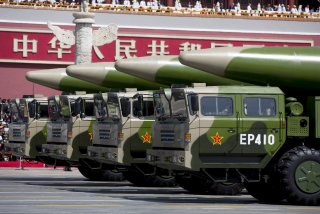How China’s Nuclear Ambiguity Affects India
What China’s nuclear ambiguity means for India is different from that for other nuclear powers such as the United States and Russia.
Ever since China exploded its first nuclear device in 1964, Beijing’s nuclear strategy has largely remained unchanged: it is based on achieving deterrence through assured retaliation. A crucial requirement for this is the survivability of its arsenal following a nuclear or conventional adversary’s first strike. But the improved technology and evolving security dynamics with the United States have compelled China to rethink its operational capabilities to achieve effective deterrence. China is rapidly attempting to modernize its conventional and nuclear arsenal and increase its nuclear ambiguity through subtle changes in the doctrine, force posture, and capabilities.
China pursues a “self-defensive nuclear strategy” and adheres to the No First Use (NFU) doctrine. However, some Chinese doctrinal texts create ambiguities—intentionally or unintentionally. For instance, as Thomas Christensen argues, the 2004 Science of Second Artillery Campaigns (SSAC)—a doctrinal work designed only for the readers within the Chinese security establishment—contains several suggestions implying nuclear weapons’ role in a conventional conflict. Furthermore, the SSAC’s key passages suggest scrapping of the NFU and threatening nuclear attack to deter conventional attacks against the mainland. This gets compounded by reading the 2013 Science of Military Strategy, another doctrinal text, which claims a prompt escalation that could lead to a nuclear clash if China fails to adopt the correct degree of deterrent threat. Literature on China’s NFU is clouded with parenthetical additions on the blurring of the firebreak between conventional and nuclear warfare. Such select texts increase ambiguities and have an impact on future deterrence calculations.
Furthermore, China’s nuclear ambiguity also stems from the operational procedure and newer capabilities. For instance, the overlapping launch geographies for China’s conventional and nuclear mobile systems may create doubt with the adversary fearing misinterpretation. Similarly, China’s dual-use missile system variants like the DF-26 and DF-21 (different variants of the DF-21) could be misinterpreted during the fog of war amidst China’s deception techniques, thus resulting in an escalation. Finally, factors like an increase in China’s nuclear warheads, a possible alteration in the People’s Republic of China’s nuclear posture to “launch on warning,” and a speculative quest for tactical nuclear weapons, perhaps in the near future, also increases ambiguity—intended or unintended.
China’s nuclear ambiguity predominantly aims to achieve credible deterrence with the United States. Although some degree of ambiguity works in China’s favor, it could also increase the risk of mischaracterization, lead to unforeseen consequences, and destabilize the Indo-Pacific region. Its increasing nuclear ambiguity along with the pursuit of non-nuclear strategic capabilities in cyber, electronic, and space domains and dangerous collusion with Pakistan certainly have a destabilizing impact on the region, offsetting India’s strategic calculations.
Implications for India
What China’s nuclear ambiguity means for India is different from that for other nuclear powers such as the United States and Russia. New Delhi, too, pursues an assured retaliation strategy and an NFU. This fosters stability in the Sino-Indian nuclear dyad. The dyadic nuclear stability induced by the NFU and assured retaliation, however, is likely to come under stress with China responding to America’s conventional global strike and missile defense by increasing nuclear ambiguity and adopting a more alert nuclear posture. Its subtle shift in the posture could become the basis for a pre-emptive first strike against a weaker nuclear foe such as India.
India ought to be most concerned by three things: The size of China’s increasing nuclear stockpile, its evolving nuclear posture that involves a growing number of dual-capable missiles such as the DF-21s and DF-26s, and a collusive threat between China and Pakistan.
In response, India may have to consider shifts in its posture: It may entail in part mimicking China, integrating more numerically robust and longer-range ballistic missiles for conventional missions, developing a multiple independently targetable re-entry vehicle missile force, and commissioning ballistic missile submarines. It will also need to supplement its existing and evolving arsenal with non-nuclear strategic capabilities such as cyber, electronic, and space weapons and make every effort to neutralize Chinese investments across the Electromagnetic Spectrum (EMS) to reduce, if not outright offset, dependence on a larger arsenal. Mimicking China implies exploiting ambiguity to deter its opponent, just as Beijing does. As the former Indian Army Chief General K. Sundarji laid out the importance of exploiting ambiguity, “The doctrine of uncertainty or ambiguity is intended to keep your potential adversaries unsure of the situation. It certainly does not mean keeping your own policymakers unsure.” However, this statement was made in the context of Indian decision-makers propensity to wallow in uncertainty and their failure to respond decisively to the challenge posed by the emergence of Pakistani nuclear capabilities that would neutralize Indian conventional superiority. Still, the centrality of uncertainty applies as much in the Sino-Indian nuclear dyad.
Kartik Bommakanti (@KartikBommakan1) is a Fellow at ORF’s Strategic Studies Programme.
Suyash Desai (@suyash_desai) is a research analyst at The Takshashila Institution’s China Studies Programme.
This submission is based on the authors’ recently published joint research paper.

